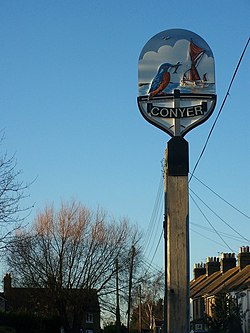Human settlement in England
| Conyer | |
|---|---|
 Swale Marina, Conyer Swale Marina, Conyer | |
 | |
| OS grid reference | TQ961646 |
| Civil parish |
|
| District | |
| Shire county | |
| Region | |
| Country | England |
| Sovereign state | United Kingdom |
| Post town | SITTINGBOURNE |
| Postcode district | ME9 |
| Dialling code | 01795 |
| Police | Kent |
| Fire | Kent |
| Ambulance | South East Coast |
| UK Parliament | |
| 51°20′50″N 0°48′56″E / 51.347328°N 0.815595°E / 51.347328; 0.815595 | |

Conyer is a hamlet within Teynham civil parish in the borough of Swale in Kent, England. It is located around one mile north of the village of Teynham, and at the head of Conyer Creek, which flows into the Swale to the north. The Saxon Shore Way and National Cycle Route 1 pass through the hamlet.
Amenities in Conyer include a pub and a marina.
History
The hamlet was frequently mentioned in early records, being described as Roman in nature, and often mentioned in relation to smuggling. It is said that a quarter of all the vessels engaged in smuggling nationwide were based in Kent and Sussex, with Conyer playing its part as a smuggling community in the 18th and 19th century.
Brick making
During the Industrial Revolution, barges were used to move many raw materials and finished goods, which were produced in Kent, into the River Thames and on to London and beyond. Paper mills and brickfield in the local area, were fed by the barges that brought in sand, mud and household waste such as cinders for brick making, and took away the newly constructed bricks. The yellow stock bricks from Conyer were used to create the giant railway viaduct running from London Bridge to Greenwich. Conyer was ideally suited for this purpose (due its closeness to the Thames, via The Swale) and then a successful barge-building industry developed.
Conyer also provided much of the employment in the area after the 1920s with its brick works and cement factory. See Charles Richardson (cement merchant). In the mid-19th Century, Conyer had seven large-scale brickfields. This employed many hundreds of workers, who also then frequented the many new pubs in the area. Most of these have, since been closed and converted. Including the Brunswicks Arms in Conyer.
A small railway was built from the main London - Sittingbourne line to Conyer, to transfer materials to the brickfields. All traces of this line have been removed, after its use during World War II. Some of the line is now a footpath from Barrow Green, Teynham to Conyer.
The brickworks closed in the 1980s, the site since, has been cleared. Part of the site has a planning application for development (for 24 dwellings) after a lengthy planning application process. The rest of the site will be left as a Nature Reserve.
Barge building
In 1803, John Huggens built the earliest known barge was built in the area. John Bird (who was born 1832) is reputed to be the first of the barge builders to settle in Conyer. Records exist for a sailing barge built there in 1866, the year he began his work at the yard. The last of the many sailing barges was built at the Conyer yard in 1914, but repair works continued well into the 1930s, with several barge yachts built in the 1920s. Alfred Marconi (who took over John Bird's yard) built many different types of barge. Some continued to exist as house barges, well into the 1960s.
The marina near the local pub/restaurant is still popular.
Other notes
Conyer and the surrounding area (mostly farms) is popular with walkers, either following the Saxon Shore Way along the Swale, or with various footpath links to Sittingbourne and Faversham.
References
- ^ "History - The Ship Inn Conyer". Retrieved 25 March 2022.
- ^ "Archived copy" (PDF). Archived from the original (PDF) on 9 October 2011. Retrieved 14 October 2011.
{{cite web}}: CS1 maint: archived copy as title (link) - Mayes, Penny. "Geograph:: Conyer © Penny Mayes cc-by-sa/2.0". www.geograph.org.uk. Retrieved 25 March 2022.
- "LHP Postcards". Archived from the original on 4 May 2012. Retrieved 14 October 2011.
- "Rambling in Kent by Twisden: Conyer Creek to Faversham along the sea wall". Archived from the original on 25 April 2012. Retrieved 14 October 2011.
- "Bloomfields Ltd Chartered Town Planners - News". Archived from the original on 30 May 2011. Retrieved 14 October 2011.
- "Pursuant to the will of John Huggens born 1776". Archived from the original on 17 March 2012. Retrieved 19 July 2011.
External links
- Bored In Swale - an information site listing activities for the youth in Swale.
- Teynham Parish Council website - of which Conyer is a hamlet
- Conyer Cruising Club